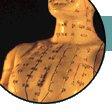Eight Extra Channels
The eight extra channels are the following group of eight
channels: Ren, Du, Chong, Dai, Yinwie, Yangwei, Yinqiao, and Yangqiao.
They differ from the twelve regular channels in that they neither
pertain to any zang or fu organ, nor do they share an exterior-interior
relationship between each other. Their main function is to regulate
the circulation of qi and blood in the twelve regular channels. When
these regular channels are overfull, excess qi and blood flow into the
eight extra channels to be stored for later use.
1. The Ren Channel
The Ren channel connects with all the yin channels of the body and is
therefore known as the "sea of yin channels." In women, it is
responsible for pregnancy and foetal nourishment.
The Ren channel commences within the lower abdomen and exits
at the perineum (1). It ascends anteriorly to the public region (2). Along
the internal abdomen, it flows upward to pass through Pt. Guanyuan
of Ren and other points, and reaches the throat (3). Flowing further
upward, it curves around the lips (4), passes through the cheek (5), and
emerges in the infraorbital region (6).
Main pathological changes: hernia, leukorrhea, lumps in the lateral
lower abdomen, irregular menstruation, abortion, infertility, etc.
2. The Du Channel
The Du channel governs all the yang channels of the body, so it is
known as the "sea of yang channels."
The Du channel commences within the lower abdomen. Traveling
downward, it appears in the perineum (1). It then flows upward inside
the spinal column (2) to the nape of the neck, Fengfu (3), entering
the brain and ascends to the vertex (4). Along the forehead, it descends
to the nose bridge, then to the lips (5), entering the labial
frenulum inside the upper lip (6).
Main pathological changes: stiffness of the spine, opisthotonos,
pain of the back, mental disorders, infantile convulsion, etc.
3. The Chong Channel
The Chong channel regulates the circulation of qi and blood of the
twelve regular channels, so it is known as the "sea of the twelve
regular channels" and the "sea of blood."
It originates in the uterus (1) where three branches immediately
arise. The first branch travels along the posterior wall of the
abdominal cavity, then ascends and runs inside the spinal column (2).
The second branch travels up to the umbilicus along the anterior wall
of the abdominal cavity (3) and spreads in the chest, then flows upward
to the throat (4) and circles around the lips (5). The third branch
descends and emerges in the perineum (6), and runs downward along the
medial aspect of the thigh (7), terminating at the big toe (8).
Main pathological changes: irregular menstruation, amenorrhea,
uterine bleeding, deficient lactation, hematemesis, etc.
4. The Dai Channel
The Dai channel possesses the function of binding and restricting other
channels. It starts below the hypochondriac region (1), runs obliquely
downward, then transversely around the waist like a belt (2).
Main pathological changes: abdominal distension and coldness of the
lumbar region, like "sitting in water."
5. The Yinwei Channel
The Yinwei channel binds the six yin channels together and joins
with the Ren channel. Commencing from the medial aspect of the lower
leg (1), it runs along the medial aspect of the thigh (2) up to the
abdomen (3) to meet with the Foot-Taiyin channel. It then passes through
the chest (4) and communicates with the Ren channel at the neck region (5).
Main pathological changes: heart pain, mental depression, etc.
6. The Yangwei Channel
The Yangwei channel connects with the six yang channels and
communicates with the Du channel. It originates at the lateral side
of the heel (1). Running upward to the external malleolus (2), it ascends
along the gall bladder channel of the Foot-Shaoyang up to the hip
region (3). Passing through the posterior aspect of the hypochondriac (4),
axillary, shoulder and neck regions (5), it further travels upward to the
cheeks (6) and forehead (7), then turns backward to the back of the neck,
where it meets with the Du channel (8).
Main pathological changes: alternate chills and fever,
low back pain, etc.
7. The Yinqiao Channel
The Yinqiao channel has the function of controlling the movements
of the lower limbs and eyelids. It starts from the posterior aspect of the
navicular bone (1), and ascends to the anterior aspect of the thigh (3), to
the external genitalia (4), it ascends further along the medial aspect of
the chest (5) to the supraclavicular fossa (6). It then passes through the
anterior aspect of Pt. Renying (7) up to the zygoma (8), and reaches
the inner canthus to communicate with the yangqiao channel (9) and
Foot-Taiyang channel.
Main pathological changes: inward splay-foot, sore throat,
hypersomnia, retention or urine, etc.
8. The Yangqiao Channel
The Yangqiao channel regulates the movements of the lower limbs
and eyelids. It starts from the lateral side of the heel (1).
Ascending along the lateral malleolus, it passes the posterior
border of the fibula. Then it runs upward along the lateral aspect
of the thigh to the abdomen and the lateral aspect of the hypochondriac
region, where it winds over the shoulder (2), passes through the neck
to the corner of the mouth (3) and enters into the inner canthus to
meet with the Yinqiao channel. It runs further upward along the
urinary bladder channel of the Foot-Taiyang to the forehead and
communicates with the gall bladder channel of the Foot-Shaoyang at
the nape of the neck (4).
Main pathological changes: outward splay-foot, insomnia, pain
in the inner canthus, etc.
|

 This website is published, edited and designed by Raymond Cheng,
and reflects only and only his personal views and opinions in his individual capacity.
The information available at this website is not intended
directly or by implication to either diagnose or treat any
medical, emotional, or psychological condition or disorder.
It is also not intended to create a physician-patient relationship
between you and I or between you and Wyith Institute™ and The Office of Dr Raymond K K Cheng.
The information here is not a substitute for advice and treatment provided
by your physician or by another healthcare professional.
It is always recommended that consultation with local healthcare providers
be obtained for any of your specific health or medical concerns.
Furthermore, any products that can be purchased (yet you can see I don't have much
to sell here) through advertisers' banners or through links to other websites
are not either explicitly or implicitly given any warranty or endorsement
by me, my colleagues, Wyith Institute™ or any of its associated businesses.
This website is published, edited and designed by Raymond Cheng,
and reflects only and only his personal views and opinions in his individual capacity.
The information available at this website is not intended
directly or by implication to either diagnose or treat any
medical, emotional, or psychological condition or disorder.
It is also not intended to create a physician-patient relationship
between you and I or between you and Wyith Institute™ and The Office of Dr Raymond K K Cheng.
The information here is not a substitute for advice and treatment provided
by your physician or by another healthcare professional.
It is always recommended that consultation with local healthcare providers
be obtained for any of your specific health or medical concerns.
Furthermore, any products that can be purchased (yet you can see I don't have much
to sell here) through advertisers' banners or through links to other websites
are not either explicitly or implicitly given any warranty or endorsement
by me, my colleagues, Wyith Institute™ or any of its associated businesses.



 Thank you for visiting this TCM and acupuncture information website.
If you have previously been to this website, you might have
noticed that some of the pages on ancient historical ideas and
holistic thinkings related to Chinese metaphysics are temporarily taken offline.
This is because I will be revamping the whole website and be moving
those information into a new \"Ancient Chinese Culture\" section
so as to reflect a more current perspective on the interpretation
of some of the fundamental concepts as well as to include
some of the latest information in the area.
But if you have just found this website for the very first time, I welcome you again and
wish you could find what you require and, hopefully, you could also be benefitted
from reading the articles I published on this website.
Thank you for visiting this TCM and acupuncture information website.
If you have previously been to this website, you might have
noticed that some of the pages on ancient historical ideas and
holistic thinkings related to Chinese metaphysics are temporarily taken offline.
This is because I will be revamping the whole website and be moving
those information into a new \"Ancient Chinese Culture\" section
so as to reflect a more current perspective on the interpretation
of some of the fundamental concepts as well as to include
some of the latest information in the area.
But if you have just found this website for the very first time, I welcome you again and
wish you could find what you require and, hopefully, you could also be benefitted
from reading the articles I published on this website.